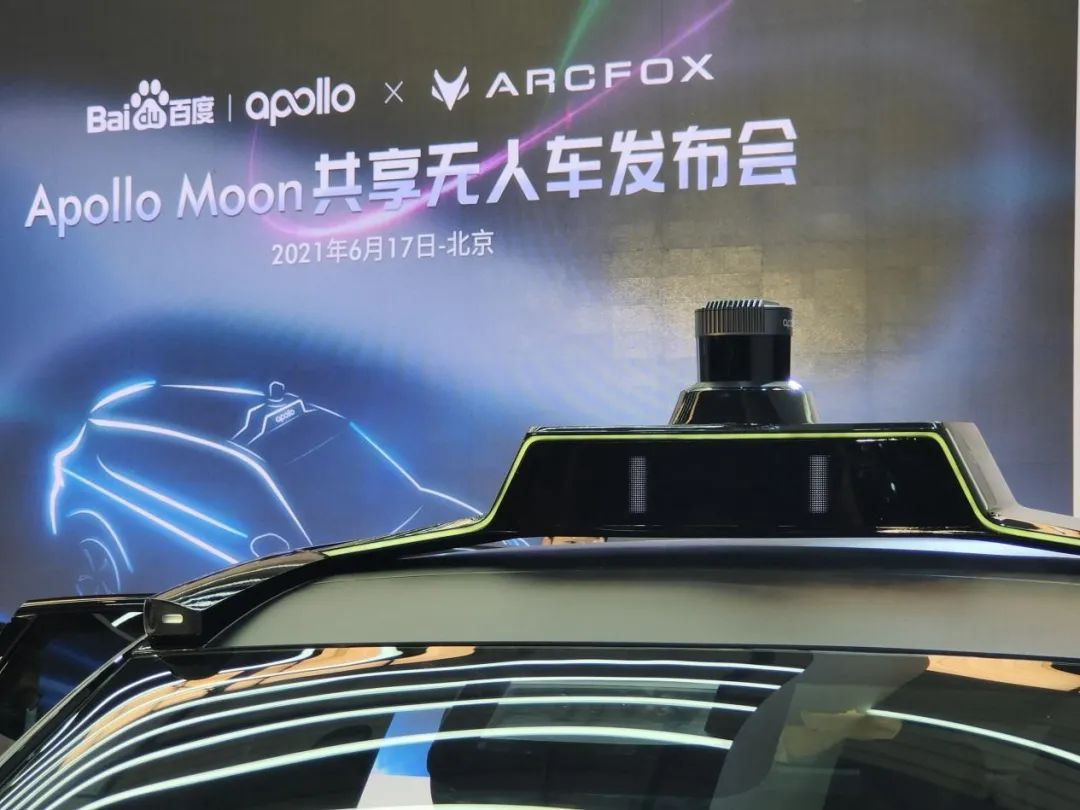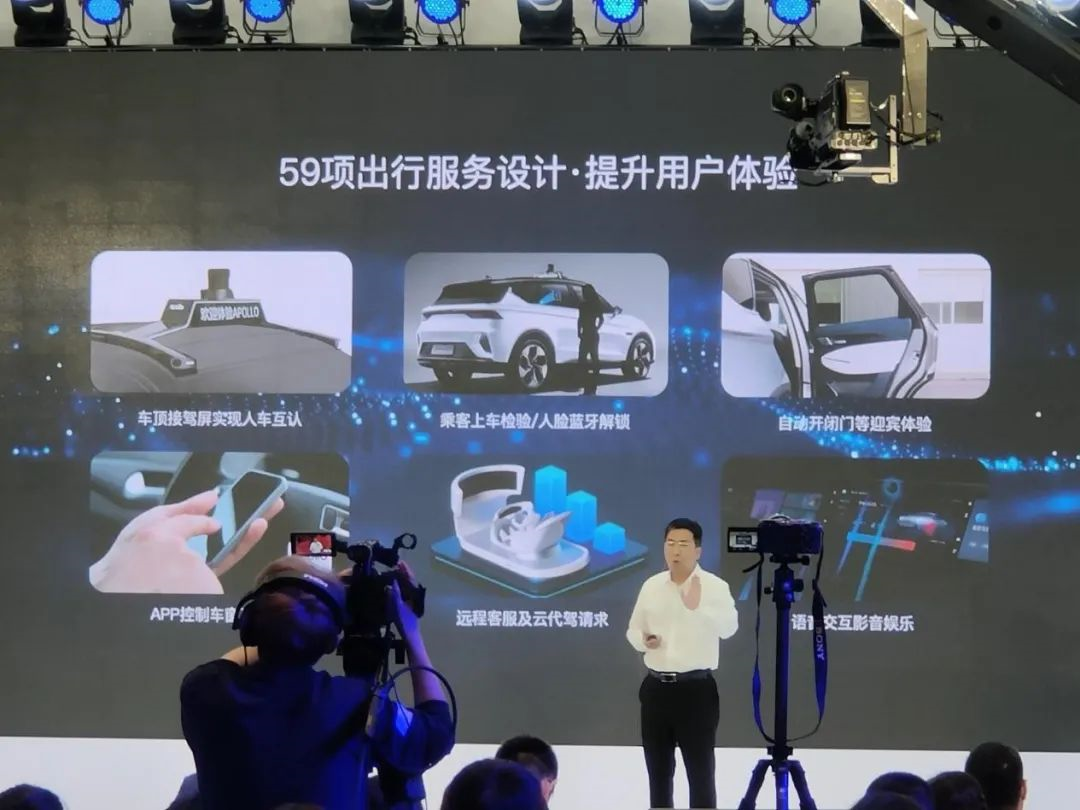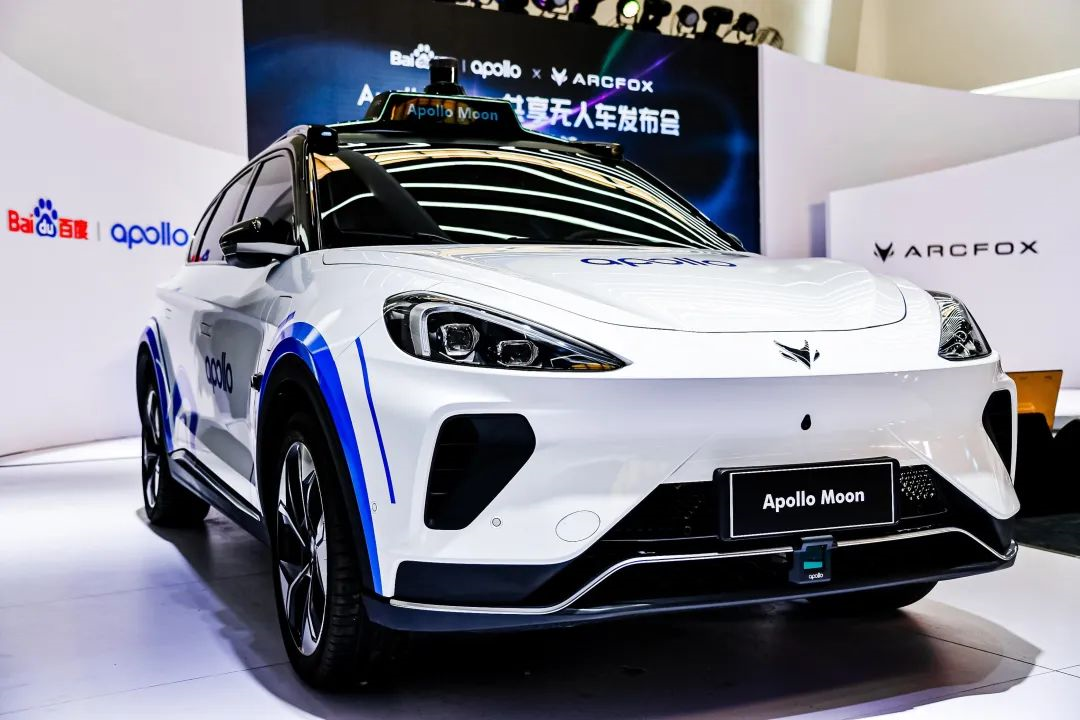Author: Mr.Yu
On the morning of June 17th, 2021, Beijing had rare good weather.
Baidu Apollo and ARCFOX, a subsidiary of Beijing Automotive Group, jointly released the new generation of mass-produced shared autonomous vehicle, Apollo Moon.
Based on the ARCFOX αT vehicle model, the Apollo Moon autonomous driving car is Baidu Apollo’s fifth-generation product since 2013. It is understood that the cost of this vehicle model is 480,000 yuan, one-third of the average cost of L4 level autonomous driving vehicle in the industry.
With strict cost control and the promotion of “becoming a new milestone for shared autonomous vehicles to truly enter mass commercialization” by Baidu Apollo, we have reason to believe that the rapid landing of Robotaxi autonomous driving ride hailing service will be the focus of Baidu Apollo this year.
As we have previously reported, Baidu has always emphasized itself as an artificial intelligence company to the public. In terms of its automotive business, Baidu has also taken intelligent driving as its key layout.
For the information and pictures sent back by Mr. Yu from the scene, colleagues of the GeekCar editorial department and Mr. Yu’s friends have raised many questions. In order to provide a more intuitive reading experience, we have decided to present key information in Q&A format.
Q1: How far can this car run? In other words, what is the service life of the entire vehicle?
A: Baidu said that the hardware reliability of the entire Apollo Moon vehicle can reach more than 20,000 hours, which means a total operating cycle of more than 5 years, providing long-term stable autonomous driving travel services.
The first three generations of Baidu Apollo’s vehicles were self-modified models, and a hardware failure might occur after running for less than 300-400 hours. Since the fourth-generation vehicle, there has been a considerable degree of improvement in stability, and its average stable operation time can reach more than 2,000 hours.

Q2: What are the technical advantages of the new car?
A: It is reported that the Apollo Moon is equipped with the fifth-generation autonomous driving suite. The total computing power of the computing platform exceeds 800 TOPS. It uses more commercially available devices to achieve the integration of the main computing system and backup safety system. To ensure stable operation of the system, Apollo Moon also uses water-cooling technology commonly found in high-performance computers, which can effectively control the noise in the car while maintaining a stable heat treatment performance.In terms of sensors, the Apollo Moon is equipped with two lidars (including one main lidar and one forward redundant lidar), 13 cameras, and a three-ring, multi-redundant sensor combination of five mmWave radars. The main lidar is jointly manufactured by Baidu and Shanghai lidar manufacturer Hesai Technology. This lidar has ultra-high resolution, which can clearly distinguish pedestrians, obstacles, and other objects, and has interference resistance, which can guarantee accurate recognition of obstacle categories, positions, speeds, accelerations, orientations, and other different benchmarks even in complex scenarios without being affected by radar interference from the vehicle. On the one hand, it can provide precise and reliable perception capability support for autonomous driving, on the other hand, cost can also be effectively controlled.
According to Wang Yunpeng, vice president of Baidu and general manager of the Autonomous Driving Division, the Baidu Apollo Moon achieves the least number of lidars, the least number of lines, and the lowest cost of using lidars worldwide.
In terms of safety, the Apollo Moon has full sensor and computing unit redundancy, perfect failure detection, and degradation processing strategies. The delivery success rate of this vehicle on complex urban roads reaches 99.99%. Even if a system fails, it can ensure that the entire vehicle still executes driving commands and transports passengers to a safe location.
In terms of software, the Apollo Moon adopts the “ANP-Robotaxi” architecture. This not only makes the shared autonomous driving kit lightweight but also promotes data synergy and sharing with intelligent driving cars, creating a data loop.
Q3: Why emphasize the cost of 480,000 RMB?
A: According to Wei Dong, vice president of Baidu’s Intelligent Driving Business Group and chief safety operation officer, the price of 480,000 RMB per vehicle is calculated based on a five-year operational period, which translates to an operating cost of about 8,000 RMB per month. In first-tier cities in China, the personnel cost of each online car-hailing driver is at the level of nearly 8,000 RMB per month. In second-tier cities in China, taking B-class business vehicles as an example, the monthly rental cost of each vehicle is around 3,000 RMB, and the monthly cost of online car-hailing is over 5,000 RMB.
Wei Dong stated that the Apollo Moon, which supports autonomous driving, already has the possibility of replacing existing premium cars in terms of cost. This cost control makes Baidu Apollo Moon qualified to enter the access threshold of online car-hailing operating costs.
Q4: How can unmanned operation be achieved in practical scenarios?A: It is known that passengers can book rides through related apps.
The Apollo Moon car roof screen has a function that displays the vehicle’s status. Passengers can customize their own personalized text and graphics. The vehicle can also unlock doors through facial recognition or Bluetooth for easy passenger-vehicle recognition.
I noticed that the familiar Baidu AI’s dot eyes appeared on this rooftop screen, occasionally looking around. It seems that this external screen is the primary hardware for direct interaction between passengers and the vehicle before boarding.
The car’s rear passenger space is equipped with an exclusive entertainment interaction screen. Passengers can watch their favorite programs, check road conditions, and control in-car temperature, windows, lights, and doors through voice and app.
The car’s doors have an automatic opening and closing function. We believe that this design is for both protecting passenger safety and enhancing the vehicle’s service “texture.”

Q5: How does Baidu Apollo’s commercialization of autonomous driving on a large scale land?
A: Combining Wang Yunpeng’s speech at the 2020 Apollo Eco Conference, Baidu Apollo has long developed its “three-step” strategy.
Firstly, for cities where road tests have been opened, Baidu Apollo will provide standardized services for users in designated areas, gradually cultivating users’ usage habits.
Secondly, for cities where large-scale fleets are operating stably under industry management, commercial trial operations will be carried out gradually under the guidance of industry management departments, including service formats, pricing mechanisms, etc., to promote the improvement of service efficiency and quality.
In the third step, Apollo Moon’s unmanned vehicle fleet will be placed on a small scale in designated areas to verify the commercialization feasibility of its business model by verifying its practicality of pure unmanned operations on the road.
To this end, Baidu has signed a strategic cooperation agreement with ARCFOXhu, and the two parties expect to deploy 1,000 shared unmanned vehicles to support the operation of autonomous driving fleets in the next three years. Recently, Baidu Apollo will start the shared unmanned vehicle landing operation in cities such as Beijing (the newly added Tongzhou area), Shanghai, Guangzhou, and Chongqing. According to Baidu Apollo’s plan, by 2023, the ecology will be developed in 30 cities nationwide, with 3,000 vehicles and 3 million registered users, achieving a “regional recyclable commercialization model.”
Based on the current situation, we believe that Baidu Apollo still needs to expand the operational areas and corresponding user bases in various cities. If it can create a positive word of mouth among users, it will have a positive driving effect on subsequent actions.
GeekCar’s ThoughtsBaidu’s layout in the field of autonomous driving started relatively early, and its unmanned vehicle project has been launched for nearly eight years, with a total investment of hundreds of billions of yuan. According to the latest data, the cumulative test mileage of Baidu’s Apollo L4 autonomous driving has exceeded 12 million kilometers, making Baidu the only Chinese company to achieve a cumulative road test of ten million kilometers. Baidu Apollo’s self-driving taxi fleet has also landed in multiple cities across China.
As we mentioned in our report in 2021, in the global autonomous driving competitiveness rankings released by the well-known consulting firm Guidehouse in April, Baidu, Waymo, NVIDIA and other companies were considered to occupy the ‘leader’ position in the forefront.
We believe that Baidu Apollo’s achievements today are worthy of recognition throughout the industry.
Regarding some details, we also have our own thoughts.
We once experienced a modified BMW 5 Series autonomous driving Robotaxi in the United States, which was already capable of full autonomous driving. After calling it via Lyft, the responding Robotaxi drove to the road in front of the hotel instead of the lobby where we were.
In other words, the high-precision map collection previously only collected the road in front of the hotel, and the short distance from the lobby still required the driver to take control.
We will not question the performance of Baidu Apollo’s autonomous driving technology in specific areas and routes, and its technological maturity. Beyond the data, what level of autonomous vehicle ride-sharing can be achieved in practical experience? Will it frequently encounter the small embarrassment mentioned above, and it remains to be verified by users.
Regarding the cooperation with Beijing Automotive Group’s BJEV, we believe it is a good start.
As the planning and development mentioned above are further implemented, with which brands will Baidu Apollo cooperate in other cities and regions? What kind of cooperation and operating strategies will be adopted? Compared with the operating mode in Beijing, how can more localized and segmented operations be achieved?
For current domestic ride-hailing users, autonomous driving travel services are still a very advanced and novel experience- to some extent, it is a bit like a shuttle bus in a scenic area.During the May Day holiday in 2021, Baidu Apollo opened its Robotaxi service to the public at the Beijing Steel Park. According to official data, since the beginning of commercial operation, Baidu Apollo autonomous Robotaxi completed a total of 848 orders in four days during the holiday, with a daily average of 212 orders and serving 1,500 passengers.
According to feedback from testers, the farthest distance between the Qunming Lake Station and the May Day Theater East Station is about 800 meters, and the usual walking time is about 10 minutes. However, Baidu Apollo’s Robotaxi can reach the destination within two minutes, but requires a fare of 30 yuan.
This is far from the average fare levels of current ride-hailing and taxi services. The establishment of the fare pricing mechanism for the upcoming commercial launch of Baidu Apollo Robotaxi will directly affect its market promotion speed and even the establishment of its business model.
Baidu Apollo was initially positioned as an L4-level autonomous driving system to replace human drivers in operation – this was emphasized once again during today’s event. We all know that China’s road environment is relatively complex, and to a large extent, the “logic of non-drivers and motor vehicle drivers is often completely different, which is also the fundamental reason for many car accidents”.
The driving experience of human drivers often includes factors other than driving skills, such as key decision-making and judgment in unexpected situations. At some level, the responsibility for driving and the level of maturity of autonomous driving are equally important.
We hope that Baidu Apollo and industry partners will quickly land their autonomous driving ecosystem and not forget to find answers to these issues as soon as possible.
This article is a translation by ChatGPT of a Chinese report from 42HOW. If you have any questions about it, please email bd@42how.com.
